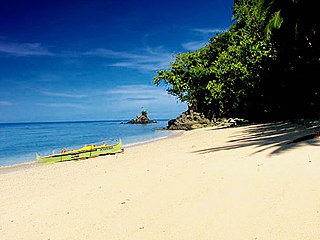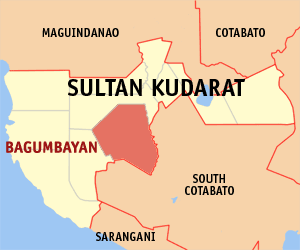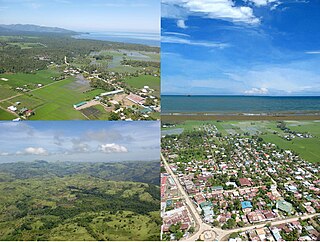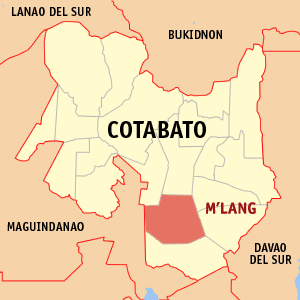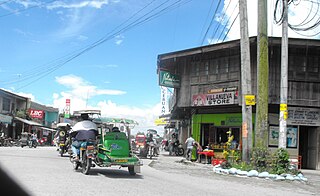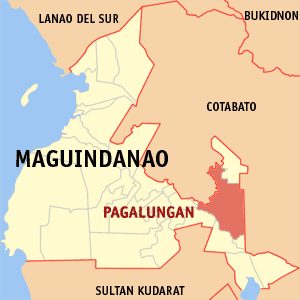Polomolok | |
|---|---|
| Municipality of Polomolok | |
 Polomolok Public Market | |
Nickname(s):
| |
| Motto(s): Padayon Polomolok! | |
 Map of South Cotabato with Polomolok highlighted | |
Location within the Philippines | |
| Coordinates: 6°13′N125°04′E / 6.22°N 125.07°E Coordinates: 6°13′N125°04′E / 6.22°N 125.07°E | |
| Country | |
| Region | Soccsksargen (Region XII) |
| Province | South Cotabato |
| District | 1st District |
| Date of Creation | August 21, 1957 |
| Founded | September 10, 1957 |
| Barangays | 23 (see Barangays) |
| Government | |
| • Type | Sangguniang Bayan |
| • Mayor | Honey L. Lumayag-Matti |
| • Vice Mayor | Xavier J. Bayan |
| • Electorate | 99,820 voters (2019) |
| Area | |
| • Total | 339.97 km2 (131.26 sq mi) |
| Population (2015 census) [3] | |
| • Total | 152,589 |
| • Density | 450/km2 (1,200/sq mi) |
| Economy | |
| • Income class | 1st municipal income class |
| • Poverty incidence | 24.6% (2015) [4] |
| • Revenue (₱) | 414,171,343.13 (2016) |
| Time zone | UTC+8 (PST) |
| ZIP code | 9504 |
| PSGC | |
| IDD : area code | +63 (0)83 |
| Climate type | tropical rainforest climate |
| Native languages | Hiligaynon Cebuano Maguindanao language Blaan language Tagalog |
| Website | polomolok |
Polomolok, officially the Municipality of Polomolok, is a 1st class municipality in the province of South Cotabato, Philippines. According to the 2015 census, it has a population of 152,589 people. [3]

South Cotabato, officially the Province of South Cotabato, is a province in the Philippines located in the SOCCSKSARGEN region in Mindanao. Its capital is Koronadal City, and it borders Sultan Kudarat to the north and west, Sarangani to the south and northeast, and Davao del Sur to the far northeast. To the southeast lies Sarangani Bay.

The Philippines, officially the Republic of the Philippines, is an archipelagic country in Southeast Asia. Situated in the western Pacific Ocean, it consists of about 7,641 islands that are categorized broadly under three main geographical divisions from north to south: Luzon, Visayas and Mindanao. The capital city of the Philippines is Manila and the most populous city is Quezon City, both part of Metro Manila. Bounded by the South China Sea on the west, the Philippine Sea on the east and the Celebes Sea on the southwest, the Philippines shares maritime borders with Taiwan to the north, Japan to the northeast, Vietnam to the west, Palau to the east, and Malaysia and Indonesia to the south.
Contents
- History
- Geography
- Climate
- Barangays
- Demographics
- Economy
- Agriculture
- Income classification
- Festivals
- Transportation
- Media
- Hospitals
- Banking institutions
- Shopping malls
- Education
- References
- External links
It is located between General Santos and Tupi. Polomolok is seated about 41 kilometres (25 mi) south-east of the provincial capital city of Koronadal, 17 kilometres (11 mi) north of the port city of General Santos and 1,030 kilometres (640 mi) south-east of the national capital Manila. The municipality ranks 21st in the largest income earner municipalities of the Philippines. [5] As of 2016, it is the wealthiest Municipality in Mindanao with PhP 1.47 Billion worth of assets and in 2017, Polomolok is the 7th Most Competitive Municipality in Mindanao for the year 2018. [6]

General Santos, officially the City of General Santos, referred to as General Santos City and abbreviated as GenSan, is a 1st class highly urbanized city in Soccsksargen, Philippines. According to the 2015 census, it has a population of 594,446 people.

Tupi, officially the Municipality of Tupi, Hiligaynon: Banwa sang Tupi; Kapampangan: Balen ning Tupi) is a 1st class municipality in the province of South Cotabato, Philippines. According to the 2015 census, it has a population of 69,976 people.

Koronadal, officially the City of Koronadal,, referred to as Koronadal City, and popularly known as Marbel, is a 3rd class city in the province of South Cotabato, Philippines. According to the 2015 census, it has a population of 174,942 people.
Polomolok already filed a resolution to the Congress for Polomolok to become a city. [7]
A city is one of the units of local government in the Philippines. All Philippine cities are chartered cities, whose existence as corporate and administrative entities is governed by their own specific municipal charters in addition to the Local Government Code of 1991, which specifies their administrative structure and powers. As of September 7, 2019, there are 146 cities.











